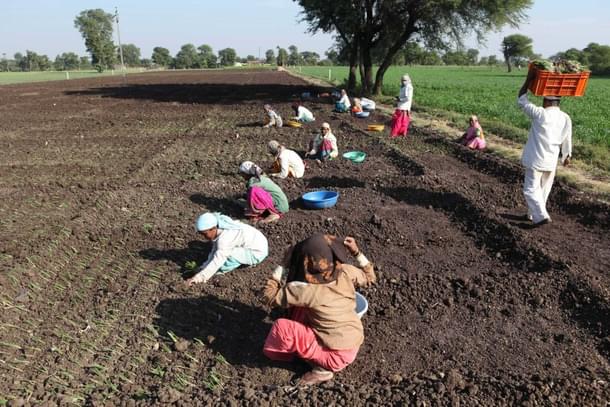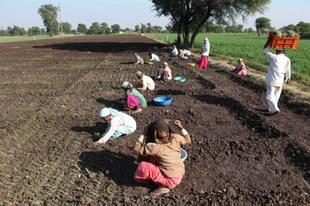Economy
Changing Agri Landscape: How The Centre Can Encourage Farmers To Grow Crops Of Its Choice
M R Subramani
Jul 23, 2019, 03:59 PM | Updated 03:59 PM IST
Save & read from anywhere!
Bookmark stories for easy access on any device or the Swarajya app.


You can also read this article in Hindi- कृषि लागत और लाभ- कैसे केंद्र अपने पसंद की फसल उगाने के लिए करे प्रोत्साहित
Can the centre encourage or lure farmers to grow crops of its choice, particularly those crops that are in short supply? For example, this year India is facing supply shortage in maize that is in demand for exporting. On the other hand, the country still depends on importing cooking oil to meet the burgeoning demand thus spending valuable foreign exchange.
A look at the Commission for Agricultural Costs and Prices (CACP) paper on Price Policy for Kharif Crops - The Marketing Season 2019-20 gives an indication that the government can influence the decision of a farmer in growing a crop of its choice. For example, farmers growing arhar (tur) or pigeon pea have gained the most in the three years between 2014-15 and 2016-17. This has happened mainly because the government had encouraged growing of this pulses crop with a higher minimum support price.
Dealing with the returns on kharif crops — grown between June and September — for the three years ending 2016-17, the commission said that the per hectare gross returns on cultivation costs, which include input costs of seeds, fertilisers and hired labour (A2) besides the implied expenditure of family labour (A2+FL), were higher for arhar at Rs 30,600.
Let us look at other features of the CACP paper.
Groundnut gave the second-highest return of Rs 25,050 a hectare, while returns were negative in cultivating niger seed with farmers losing Rs 1,710 a hectare due to lower yield. Among cereals, paddy, a water guzzler, gave the highest return of Rs 17,675 followed by maize (corn) at Rs 12,261. Compared to cereals, cotton offered better returns at Rs 21,123 a hectare, while the return on nutri-cereals (millets) like bajra, jowar and ragi were below Rs 6,000 a hectare owing to poor productivity.
Gross returns on urad (black matpe) were higher at Rs 20,072. However, moong (split green gram) fetched returns lower than Rs 9,000 a hectare. Among oilseeds, sesamum (til) gave Rs 12,671 a hectare return, while sunflower yielded Rs 7,130. Soybean, the crop that tops in acreage in kharif oilseeds sowing, gives a return of only Rs 5,714 a hectare.
The commission used these statistics for arriving at the costs of cultivation for 14 crops, while recommending minimum support price for kharif crops this year. Again, the CACP considered the costs from only the states that made a significant contribution to the country’s production.
In terms of gross relative returns, the average returns for arhar was 174 per cent compared with the cultivation costs (A2+FL). Groundnut gave a return of 142 per cent, while urad provided 114 per cent return. Cotton gave a return that was 120 per cent to the cultivation costs, while paddy’s yield was 100 per cent.
CACP said farm labour costs for farmers increased 6.4 per cent last year going by current prices. If constant prices were taken into consideration, then the costs rose by five per cent. State-wise, the rise in labour costs (at current prices) was the highest in Rajasthan at 12.4 per cent, while it was the least in Odisha at 0.6 per cent.
The CACP, in its recommendations for support price this year, said farmers need to be incentivised for adopting newer technologies, developing production pattern in tune with changing national requirements and rationale for the use of land, water and other resources.
This year, the CACP recommendation for minimum support prices — approved by the Cabinet earlier this month — was based on cultivation costs, demand-supply situation, inter-crop price parity, trade terms with non-agricultural products and prices in domestic as well as global markets. The impact of the price policy on the economy and ensuring minimum 50 per cent return on the costs incurred by farmers were also taken into account.
Expressing concern over subdued prices for nutri-cereals, the CACP said states should include them in the public distribution system, mid-day meals, other welfare schemes and focus on value-added strategies besides processing them as multi-grains.
The CACP said that productivity of crops in India suffered on account of two problems. First, the per hectare yield in the country is much lower than the world’s average and two, there is a vast spatial variation in productivity due to differences in agro-climatic regions.
Productivity in cereals such as rice, maize, bajra, jowar and ragi has been the lowest in the last 15 years at 1.46 per cent. The area under total cereals dropped 0.55 per cent in the five years ending 2018-19, while growth in productivity decelerated at 2.06 per cent. Kharif cereals production had slowed to two per cent during the period, while the area under cereals dropped to 0.71 per cent.
On the other hand, production of pulses increased 8.76 per cent, while productivity was up 3.18 per cent in the five years to 2018-19. Kharif pulses production increased 11.5 per cent during the period, though yield growth was up 4.56 per cent only compared with 5.95 per cent in the five-year period ending 2013-14.
Oilseeds yield and production dropped during the period mainly since the area under cultivation of the crops declined by 3.08 per cent. This was in comparison to a good growth witnessed in oilseeds in the last two decades — probably because the government lost focus on this. Cotton is another crop for concern with its productivity slipping 3.28 per cent in the five-year period, while growth in the area under the fibre crop decelerated to 0.96 per cent. This led to fall in production by 3.12 per cent quinquennial (five-year period) ending 2018-19. This can be attributed to farmers not getting their hands on new varieties after the old varieties have begun to lose their potency.
The CACP report is a pointer to the change that Indian agriculture is witnessing with farmers looking to grow crops that provide them with higher yield and returns. In addition, the centre’s policy of encouraging certain crops like pulses through higher minimum support prices seems to be working.
Probably, the government can achieve its objective of targeting growth of specific crops if it can encourage the grower early in the season to plant the desired crop. For that, the announcement of minimum support price will have to come well before farmers plan on which crop to grow in that season.
M.R. Subramani is Executive Editor, Swarajya. He tweets @mrsubramani




